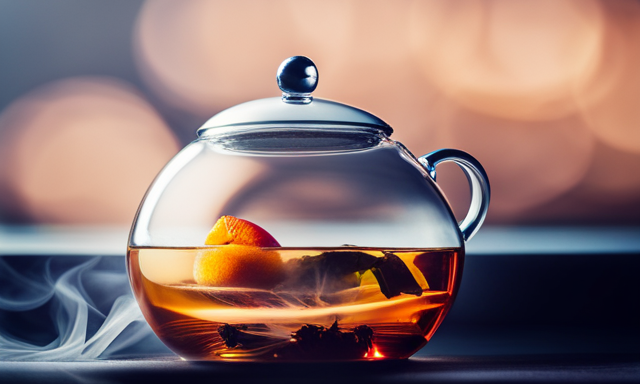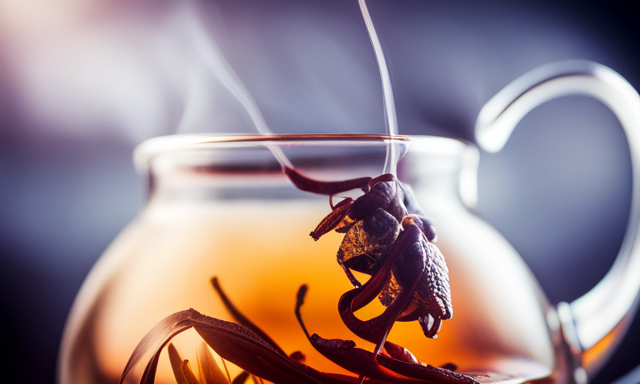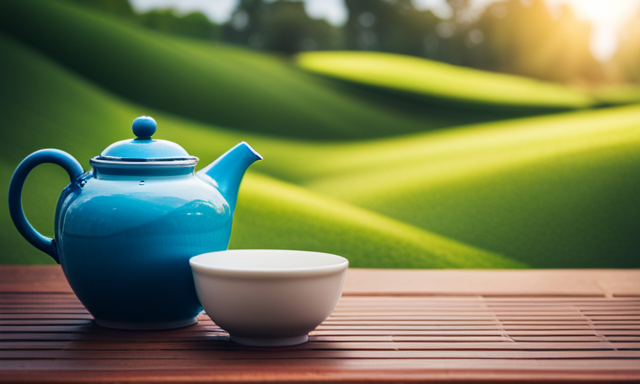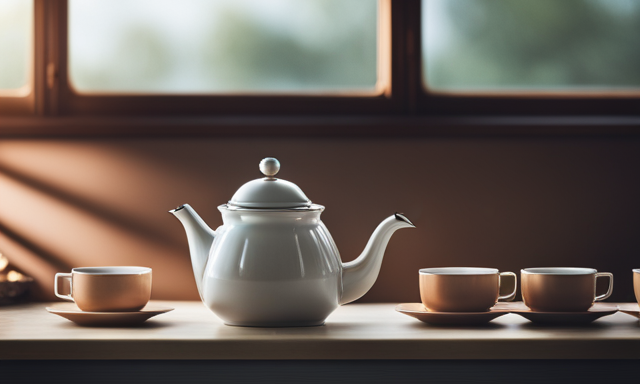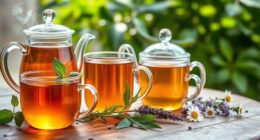Picture yourself on a warm summer day, sitting outside on a patio, enjoying a refreshing beverage that quenches your thirst and delights your taste buds. Now, imagine that drink being a perfect blend of fruity sweetness and the smooth, aromatic notes of tea. That, my friends, is the essence of peach oolong tea.
In this article, we will dive into the world of peach oolong tea, exploring its origins, flavor profile, health benefits, and even some delicious recipes and pairings. I will guide you through the process of brewing and serving this delightful drink, and show you where to find the highest quality peach oolong tea.
But peach oolong tea is more than just a beverage; it carries a cultural significance and has become a global favorite. So, let’s embark on this journey together and discover what makes peach oolong tea so special. Get ready to sip and savor the enchanting flavors of this delightful tea.
Key Takeaways
- Peach oolong tea embodies age-old traditions and cultural significance, symbolizing longevity, immortality, wisdom, and balance in Chinese culture.
- The blend represents the unity and appreciation for diverse traditions, as it combines the symbolic meanings of peaches (longevity and immortality) and oolong tea (wisdom and balance).
- Peach oolong tea’s global popularity is attributed to its delightful combination of fruity sweetness and aromatic richness, appealing to a wide range of taste preferences.
- Successful marketing strategies, increased peach cultivation worldwide, and effective distribution have made peach oolong tea easily accessible and beloved by tea enthusiasts worldwide.
History and Origins of Oolong Tea
Oolong tea, with its rich and complex flavors, has a fascinating history that dates back to ancient China. The cultivation of oolong tea began in the Fujian province during the Song Dynasty.
This unique tea is made from the leaves of the Camellia sinensis plant, which are withered under the sun and then oxidized. The oxidation process gives oolong tea its distinct taste and aroma.
The history of oolong tea is intertwined with Chinese culture and it has been enjoyed for centuries for its health benefits and delicious taste.
Now, let’s dive into an overview of peach oolong tea, a delightful blend that combines the natural sweetness of peaches with the unique flavors of oolong tea.
Overview of Peach Oolong Tea
Peach oolong tea is a delightful blend of high-quality oolong leaves and the natural essence of ripe peaches. The combination of the smooth, slightly earthy oolong tea with the sweet and tangy notes of peach creates a harmonious and refreshing taste experience.
To fully enjoy the flavor profile of peach oolong tea, it is important to use the right brewing techniques. Steep the leaves in water that is around 195°F for 3-5 minutes to extract the perfect balance of flavors. The resulting brew showcases the tea’s natural sweetness, complemented by the subtle hint of peach.
This infusion is a delightful choice for those seeking a refreshing and flavorful tea experience. Transitioning into the subsequent section, let’s explore the flavor profile and aroma of peach oolong tea.
Flavor Profile and Aroma of Peach Oolong Tea
The delicate aroma and taste of summer are captured in this delightful blend, creating a harmonious and refreshing experience for the senses. Peach oolong tea is known for its unique flavor characteristics and enticing aroma. The combination of the earthy oolong tea leaves with the sweet and juicy peach flavor creates a perfect balance that is both soothing and invigorating. The flavor profile of peach oolong tea is a wonderful blend of fruity sweetness and subtle floral notes, making it a truly enjoyable beverage.
To fully appreciate the flavor of peach oolong tea, it is important to use proper brewing techniques. The water should be heated to around 195°F (90°C) and the leaves should be steeped for about 3-5 minutes. This will allow the flavors to infuse into the water, resulting in a rich and flavorful cup of tea.
Moving on to the health benefits of oolong tea and peaches…
Health Benefits of Oolong Tea and Peaches
Indulge in the delightful combination of flavors and experience the numerous health benefits that this unique blend has to offer.
Peach oolong tea not only tantalizes your taste buds with its sweet and fruity notes, but it also provides a range of health benefits. Oolong tea is known for its ability to boost metabolism and aid in weight management. It contains antioxidants that help fight free radicals and promote overall wellness.
Peaches, on the other hand, are rich in vitamins A and C, which support a healthy immune system and skin. Together, these two ingredients create a powerhouse of nutrients that can enhance your well-being.
So, sip on a cup of peach oolong tea and let its delicious flavors and health benefits nourish your body and soul.
Moving on to brewing and serving tips for peach oolong tea, let’s explore the best way to enjoy this delightful beverage.
Brewing and Serving Tips for Peach Oolong Tea
To fully savor the rich aroma and delicate flavors of this exquisite blend, prepare your peach oolong tea by steeping it at the recommended temperature for optimal taste and maximum health benefits.
Brewing techniques for peach oolong tea are crucial to bring out the perfect balance of fruity sweetness and floral notes. Start by boiling fresh, filtered water and letting it cool for a minute or two before pouring it over the tea leaves.
Steep the tea for around 3-4 minutes to achieve the ideal infusion. For a stronger flavor, you can increase the steeping time, but be cautious not to overbrew and compromise the delicate flavors.
To enhance the taste, serve peach oolong tea hot or over ice. It pairs well with a squeeze of lemon or a sprig of mint.
As we delve into the different varieties and blends of peach oolong tea, you’ll discover even more delightful ways to enjoy this refreshing beverage.
Different Varieties and Blends of Peach Oolong Tea
Immerse yourself in a world of diverse flavors and aromatic combinations by exploring the wide array of peach oolong tea varieties and blends.
Peach oolong tea comes in different flavor profiles, allowing you to find the perfect combination that suits your taste buds. Some varieties offer a delicate and floral taste with hints of peach, while others have a stronger, more robust flavor.
The brewing techniques for peach oolong tea can vary depending on the type of tea you have. Generally, it’s recommended to use water that is just below boiling temperature and steep for 3-5 minutes. This will ensure that you extract the optimal flavors without any bitterness.
Now, let’s move on to popular peach oolong tea recipes and pairings, where you can discover unique ways to enjoy this delightful tea.
Popular Peach Oolong Tea Recipes and Pairings
Discover mouthwatering recipes and delightful pairings that will have you savoring the perfect blend of fruity sweetness and aromatic notes in every sip.
When it comes to peach oolong tea, the possibilities are endless. One popular choice is to create refreshing peach oolong tea cocktails. Simply mix chilled peach oolong tea with a splash of vodka or rum, add some fresh peach slices and a squeeze of lemon, and you have a deliciously fruity and boozy beverage that is perfect for summer gatherings.
If you have a sweet tooth, try incorporating peach oolong tea into your desserts. Infuse the tea into your favorite cake or cupcake recipe, or use it to create a delectable peach oolong tea-infused ice cream. The options are limitless!
Now that you know how to create these amazing recipes, let’s move on to where to buy and source high-quality peach oolong tea.
Where to Buy and Source High-Quality Peach Oolong Tea
Now that we’ve explored some popular recipes and pairings for peach oolong tea, let’s move on to the next topic: where to buy and source high-quality peach oolong tea.
As a tea enthusiast, I always strive to find the best teas available, and peach oolong is no exception. There are a few places where you can find this delightful tea.
-
Specialty Tea Shops: These shops often carry a wide variety of high-quality teas, including peach oolong.
-
Online Retailers: Many online tea retailers offer a vast selection of teas, and you can easily find peach oolong tea on their websites.
-
Local Farmers Markets: Some farmers markets have vendors who sell artisanal teas, including peach oolong.
Drinking peach oolong tea has several benefits. It contains antioxidants that help support overall health and well-being. Additionally, the natural peach flavor adds a delightful sweetness to the smooth oolong base, making it a refreshing and enjoyable beverage.
Now, let’s delve into the cultural significance and traditions surrounding peach oolong tea.
Cultural Significance and Traditions Surrounding Peach Oolong Tea
The rich cultural significance and age-old traditions surrounding peach oolong tea are worth exploring. This beloved beverage holds a special place in the hearts of many cultures, thanks to its unique flavor profile and symbolic meaning. In Chinese culture, peaches symbolize longevity and immortality, while oolong tea represents wisdom and balance. When these two elements are combined in a tea, they create a harmonious blend of flavors and embody cultural traditions and values. The preparation and serving of peach oolong tea often involve rituals and ceremonies, underscoring its importance in cultural celebrations. As we delve into the global popularity of peach oolong tea, we will discover how this cherished beverage has transcended borders and captivated the taste buds of tea enthusiasts worldwide. It has become a symbol of unity and appreciation for diverse traditions.
Exploring the Global Popularity of Peach Oolong Tea
Indulging in a cup of this beloved beverage will take you on a journey around the world. You will uncover the global appeal and widespread love for the delightful combination of fruity sweetness and aromatic richness.
The global popularity of peach oolong tea can be attributed to several factors. Firstly, its successful marketing strategies have made it easily accessible to tea enthusiasts in different countries. Peach oolong tea has been effectively marketed and distributed worldwide.
Secondly, the growth of peach cultivation worldwide has contributed to the availability of fresh and high-quality peach flavors for oolong tea production. The increased cultivation of peaches in various regions has ensured a steady supply of fresh peaches for the production of peach oolong tea.
Lastly, the unique blend of peach and oolong tea appeals to a wide range of taste preferences. This diverse palate appeal makes peach oolong tea a popular choice among tea lovers globally. The delightful combination of fruity sweetness from the peaches and the rich aroma of oolong tea is a winning combination.
With its global marketing efforts and the availability of fresh peaches for cultivation, peach oolong tea has successfully captured the hearts and taste buds of tea enthusiasts worldwide.
Frequently Asked Questions
What is the recommended steeping time and temperature for peach oolong tea?
For the perfect cup of peach oolong tea, steep it at 195°F for 3-4 minutes. This temperature and time combo will extract the rich flavors without making it too strong or bitter. Enjoy the sweet, fruity goodness!
Are there any known side effects or allergies associated with peach oolong tea consumption?
There are no known side effects or allergies associated with peach oolong tea consumption. It is generally safe to drink and provides a flavorful and refreshing experience. Enjoy a cup without worry!
Can peach oolong tea be enjoyed both hot and cold?
I love enjoying peach oolong tea both hot and cold! It’s like sipping on a refreshing summer breeze when chilled, and a cozy hug on a chilly day when enjoyed hot. The flavor variations are delightful, and the health benefits are an added bonus.
Is peach oolong tea naturally sweet or is sweetener needed to enhance the flavor?
Peach oolong tea is naturally sweet, thanks to the combination of ripe peaches and the delicate flavors of oolong tea. No sweetener is needed to enhance the flavor. Additionally, peach oolong tea provides numerous health benefits, including antioxidants and potential weight loss support.
What is the caffeine content in peach oolong tea compared to other types of tea?
In terms of caffeine content, peach oolong tea generally contains less caffeine compared to black tea but more than green tea. However, it’s important to note that the specific caffeine levels can vary depending on the brand and brewing method. As for health benefits, oolong tea is known for its potential to boost metabolism and aid in weight management, promote heart health, and improve brain function.
Conclusion
In conclusion, Peach Oolong Tea is a delightful blend that combines the rich history of Oolong Tea with the sweet and enticing flavor of peaches. Its unique flavor profile and enticing aroma make it a popular choice among tea enthusiasts worldwide.
Not only does it provide a refreshing and enjoyable experience, but it also offers numerous health benefits, thanks to the antioxidants found in both Oolong tea and peaches.
So, why not indulge in a cup of Peach Oolong Tea and experience the best of both worlds? As the saying goes, "It’s like a peachy dream come true!"

